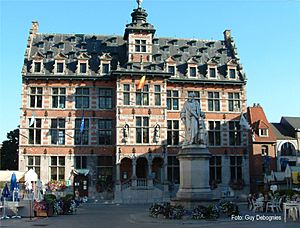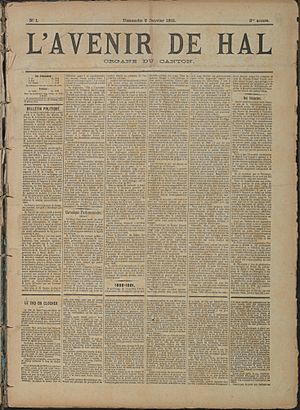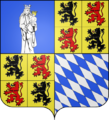Halle, Belgium facts for kids
Quick facts for kids
Halle
Hal (French)
|
|||
|---|---|---|---|

The Grote Markt
|
|||
|
|||
| Country | Belgium | ||
| Community | Flemish Community | ||
| Region | Flemish Region | ||
| Province | Flemish Brabant | ||
| Arrondissement | Halle-Vilvoorde | ||
| Area | |||
| • Total | 44.40 km2 (17.14 sq mi) | ||
| Population
(2018-01-01)Lua error in Module:Wd at line 1575: attempt to index field 'wikibase' (a nil value).
|
|||
| • Total | Lua error in Module:Wd at line 1,575: attempt to index field 'wikibase' (a nil value). | ||
| Postal codes |
1500, 1501, 1502
|
||
| Area codes | 02 | ||
| Website | www.halle.be | ||
Halle (Dutch pronunciation: [ˈɦɑlə]; French: Hal, pronounced [al]) is a city and municipality in Belgium. It is located in the Flemish Brabant province. Halle is found on the Brussels–Charleroi Canal. It sits on the Flemish side of the language border. This border separates Flanders (where Dutch is spoken) and Wallonia (where French is spoken).
Halle is about 22 kilometers (14 miles) southwest of Brussels. The official language in Halle is Dutch. This is the same for the rest of Flanders. The municipality includes the city of Halle itself. It also includes the towns of Buizingen and Lembeek. Halle's population has grown from about 32,758 people in 1991 to 39,536 in 2019. The current mayor is Marc Snoeck. He is a member of the Vooruit political party.
Contents
Discovering Halle's Past
Ancient Times and Middle Ages
Halle has always been important because of its location. Long ago, before the Romans, a group called the Nervii lived here. In the 7th century, Saint Waltrude gave some land around Halle to a church. From then on, Halle was linked to the County of Hainaut.
In the 8th century, a church for the Blessed Virgin Mary was started. This may have been the beginning of the special devotion to Mary in the area. Halle grew quickly. In 1225, it was given special rights, called "freedom charters." A famous statue of the Virgin Mary came to Halle in 1267.
Many important people visited Halle because of the Mary statue. These included Edward I of England and Ludwig the Bavarian. This made Halle an important border town. A larger church for Mary was finished in the 15th century. When Philip the Bold died in Halle in 1404, it helped the city. Later dukes visited his grave there. In 1460, Louis XI of France buried his baby son in the Halle church.
Renaissance and Modern Era
After Mary of Burgundy died, parts of Belgium rebelled. But Halle stayed loyal to the Holy Roman Emperor. In 1489, armies from Brussels tried to take Halle twice but failed.
In the 16th century, Brussels and Halle had religious disagreements. Brussels was mostly Protestant, while Halle was Catholic. Again, two attempts to conquer Halle failed. This made people in Halle feel even more devoted to their miraculous statue. In 1621, the Jesuits were invited to start schools in Halle. This helped spread their religious influence.
Later, wars in the 17th century caused problems for Halle. But in the 18th century, the city became prosperous again. The French Revolution at the end of the 18th century stopped many religious practices. However, the people of Halle saved their pilgrimage site and the statue. When Napoleon came to power, religious services were restored. Important visits to the Halle church continue even today.
Today, Halle is a center for services and care. It has shops, schools, a hospital, and public services. Most people in Halle work in the services sector. In February 2010, a serious train crash happened in Buizingen, near Halle. About 18 people died in this accident.
Halle's Flag and Coat of Arms
Halle's flag was officially adopted in 1991. It has a special design, divided into four parts. Two parts are white, and two are blue. If you cut the flag in half and flip the sides, you can see a blue diamond shape. This shape hints at Bavaria, a region in Germany.
The municipal coat of arms also tells a story. One part shows a white Virgin Mary with a child on a blue background. Another part shows the coat of arms of the Wittelsbach family. The other two parts show the coat of arms of Hainaut. This highlights Halle's important position on the language border.
Famous Buildings in Halle
- The Sint-Martinusbasiliek is a beautiful church. It is also known as the Gothic Church of Our Lady. This church is a popular pilgrimage site. It has a famous statue of the Holy Virgin, which is a Black Madonna.
- The old city hall is on the main market square. It was built during the Renaissance period.
- The former Jesuit college now holds a music and dance academy.
- The South-West Brabant Museum moved to a building called Den AST in 2014. It has items related to the life of Adrien-François Servais. He was a famous cellist and composer. The museum also has items from his son-in-law, Cyprian Godebski. He was a Polish sculptor who made the statue of Servais in front of the town hall.
Fun Events in Halle
- Carnival is celebrated every year at the start of Lent. This is a three-day event full of color. Different groups create floats and costumes. They also perform dances. The Halle carnival started in 1905. It has become one of the biggest carnivals in Belgium.
- On Easter Monday, the Sint-Veroonprocessie takes place. This is a religious procession. The relics of Saint Veroon are carried around the village of Lembeek.
- Halle is a popular place for a pilgrimage to the Blessed Virgin Mary. This tradition has been happening for at least 700 years.
- The Hallerbos is a forest near Halle. It is famous for its bluebell flowers. These flowers cover the forest floor for a few weeks each spring. Many visitors come to see this beautiful sight.
Famous People from Halle
- Jozef Cardijn (1882–1967) started the Young Christian Workers group. He also became a cardinal.
- Justus Lipsius (1547–1606) was a scholar. He wrote his first historical book about Halle.
- Philip II, Duke of Burgundy (1342–1404) died in Halle.
- Adrien-François Servais (1807–1866) was a composer and cellist. There is a statue of him in Halle's main square. His son-in-law, Cyprian Godebski, created it.
- Koen Wauters (born 1967) is a singer, TV presenter, and racing driver.
Special Products from Halle
- Duivelsbier is a local beer. It is now brewed by the Boon Brewery.
- The famous Lambic beer might have gotten its name from the village of Lembeek. Lembeek is now part of Halle.
- Halle used to have its own newspaper. It was called the future of Halle (l'Avenir de Hal).
Halle's International Connections
Halle is twinned with several cities around the world. This means they have a special friendship.
- Czech Republic: Kadaň

- Germany: Werl

- France: Mouvaux, near Lille

Images for kids
See also
 In Spanish: Halle (Bélgica) para niños
In Spanish: Halle (Bélgica) para niños










